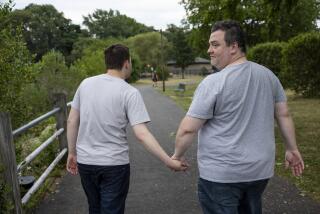Miniature brain in a dish reveals an outsized secret about autism
- Share via
Scientists hoping to uncover the origins of autism have grown a passel of miniature proto-brains in a lab, using reprogrammed skin cells to rewind the clock to the brain’s earliest days of development. From these small creations have come potentially big insights into autism, a diabolically complex disorder.
Peering into the “organoids” they created -- clusters of embryonic brain cells smaller than one-tenth of an inch across -- the authors of the new research were able to observe that as the autistic brain is under construction, it overproduces the brain cells that act to quiet the cacophony of neural activity in the brain.
The result, compared with a typically developing brain, is that the developing brain of a child who would go on to develop autism has an imbalance of excitatory and inhibitory neurons. That, said Yale physician and neurobiologist Flora Vaccarino, is a subtle but potentially powerful difference that may help pinpoint at least one bit of faulty wiring that leads to autism’s behavioral symptoms.
The new research was published Thursday in the journal Cell.
Vaccarino and her colleagues go on to report that when they suppressed a single gene that was abnormally active in organoids created from patients with autism, the researchers were able to correct the imbalance between neurons that quiet cellular impulses and those that amplify them.
The research has many hurdles to surmount before it might be used to diagnose and treat autism when a baby is still in utero, or just after birth, said Vaccarino. But, she added, the idea that their organoids may have given up a key secret of autism’s cause “could give us something to focus on in developing treatments.”
While the insights into autism generated by the new research may be important, the methods used by Vaccarino and her colleagues are quite novel as well. First, the scientists used new lab procedures that have been shown to make skin cells revert to an undifferentiated form, like those harvested from embryos. The study authors then nudged the resulting stem cells to start the process of building a brain, and incubated the result for a month or more.
The skin cells they used to create those “telencephalic organoids” came from four patients who shared a unique characteristic typical of those with severe autism: an enlarged brain and an unusually large head. To create a comparison batch of typically developing organoids, they used skins cells from the autism patients’ unaffected fathers.
For at least 31 days, and as long as 100 days, they let these reprogrammed brain cells divide, differentiate and grow. This gave the researchers a ringside seat from which to watch, in miniaturized form, the development of autistic and normal brains typical of a pregnancy’s second trimester.
(Vaccarino said that the process would be incapable of generating a true brain, which requires many tissues, including bone, meninges and fatty sheaths, that reprogrammed skin cells cannot make. But the proto-organ did exhibit some differentiation, as stem cells became radial glial cells, intermediate progenitor cells and neurons.)
Replicating the brain development process during this crucial time may be the best way to unravel the mysteries of autism, Vaccarino said.
Genomic sequencing has found no single genetic variation -- or group of variations -- that explain autism in all its forms and complexity. Epidemiological studies suggest that environmental factors ranging from pesticide exposure to a father’s age play a role. But none of those findings explain why autism affects some with those factors and not others.
To glean where the programming glitch is that lies at the root of autism -- and how it might be fixed -- Vaccarino said she and her colleagues had to watch brain development pretty much from the start -- a challenge that only a brain built from stem cells could meet.
“Sometimes you don’t see these things unless you look for them,” she said in an interview Thursday.
Like brains? Follow me on Twitter @LATMelissaHealy and “like” Los Angeles Times Science & Health on Facebook.
ALSO:
Why screams are scary (hint: It’s not because they’re loud)
For fourth time in history, space station crew forced to hide from space junk
Scientists ‘stumped’ by odd geologic feature on Pluto’s moon Charon







